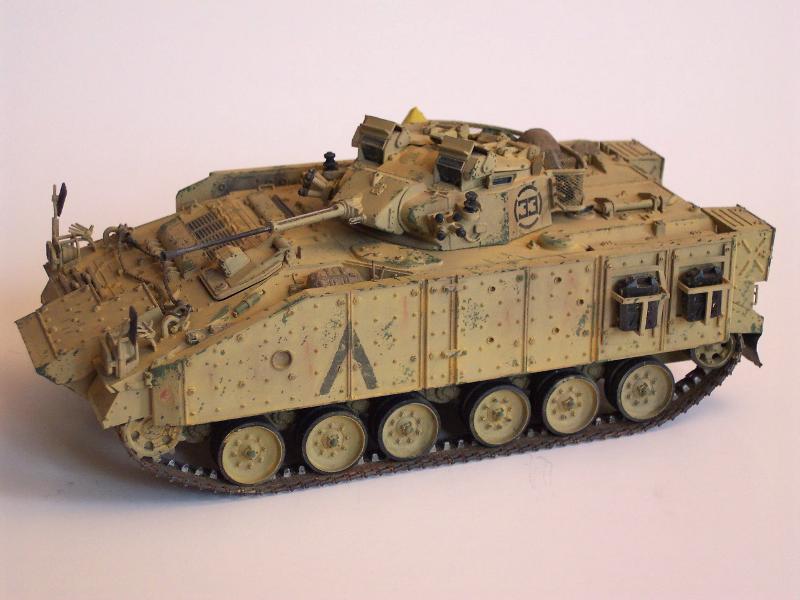
FV
510 Warrior
Réf
: Academy #1365
The Warrior has been the British mechanized infantry combat vehicle since 1987. It was designed to keep up with the Challenger 2. It is continuously upgraded, the last feature being a thermal imager increasing its night fighting capacity.
Warrior infantry vehicles are equipped with a turret mounted 30mm Rarden cannon capable of defeating light armored targets up to 1,500m night and day thanks to an 8x magnification image-intensifying night sight. It secondary armament is a co-axial 7.62mm MG. It also carries 8 Light Anti-Armour Weapons (LAW) 94mm HEAT rockets.
The main Warrior variants are an artillery observation post vehicle (OPV), a command post vehicle (CPV) and a recovery and repair vehicle. All variants are equipped with a 7.62 mm chain gun.
The infantry variant has a crew of 3 and carries 7 troops.
The kit
The kit is issued by Academy and is the
early release. Indeed, following Op Telic a reissued kit with
added sprues has hit the shelves.
It has 4 sprues, 2 vinyl tracks, 1 decals sheet, a piece of mesh
and a tread for the cables. It can be built either with or
without the add-on armor package. The 12-page notice is clear and
comprizes 16 stages. 3 decoration schemes are proposed.
The detail is good and so is the fit. The main flaw is the wrong dimensioned front armor package and stowage bin. However, I did not correct this by the time I built the kit just because I was not aware of it. Some minor mods have been done and will follow.
The chassis has separate roadwheels arms. The wheels fit thanks to poly caps in the Tamiya fashion. The drawback of this system is the lack of inner details of the wheels but it greatly helps the further fitting of the vinyl tracks.
The hull offers interesting features like
hatches inner detailing, separate engine hatch but unfortunately
no interior parts are present, no more than AM parts I'm aware of.
The troop compartment hatches are moveable and the vision ports
can be oriented. The mesh bin on the hull right side has its
straps molded. It is easy to sand them off and replace them by
lead foil with PE buckles.
The camo net supporting poles brackets can be cut and replace by
drilled plastic rods. This will remain hardly visible though.
The fire extinguishers appear undersized.
At this stage, the choice of using the armored skirts must be
made as the standard skirts will prevent them to fit properly.
The rear mud flaps being too thick, they are replaced by lead foil.
The turret is easy to build except for
the stowage bin. Its frame does not fit well and the issued mesh
hardly sticks. I replaced it by metallic one. Academy gives a
template for all the mesh parts.
The TC and gunner sights come in 9 parts each and can be
represented closed or open.
The smoke dischargers lack their wiring and a little square part
in which it plugs. These details are added with plastic card and
metal wire.
The cannon muzzle is already drilled out but can still be
improved by thinning its inner face.
Some water cans are issued by Academy along with their brackets to fit on the add-on skirts.
The camo scheme is overall sand to depict a 7th armoured division vehicle in Operation Sabre. Other variants include a BAOR and a UN service Warriors.
This kit is a nice one and is an excellent basis for all the conversions issued by Accurate Armour which too released the first resin kit of the Warrior long before Academy one.